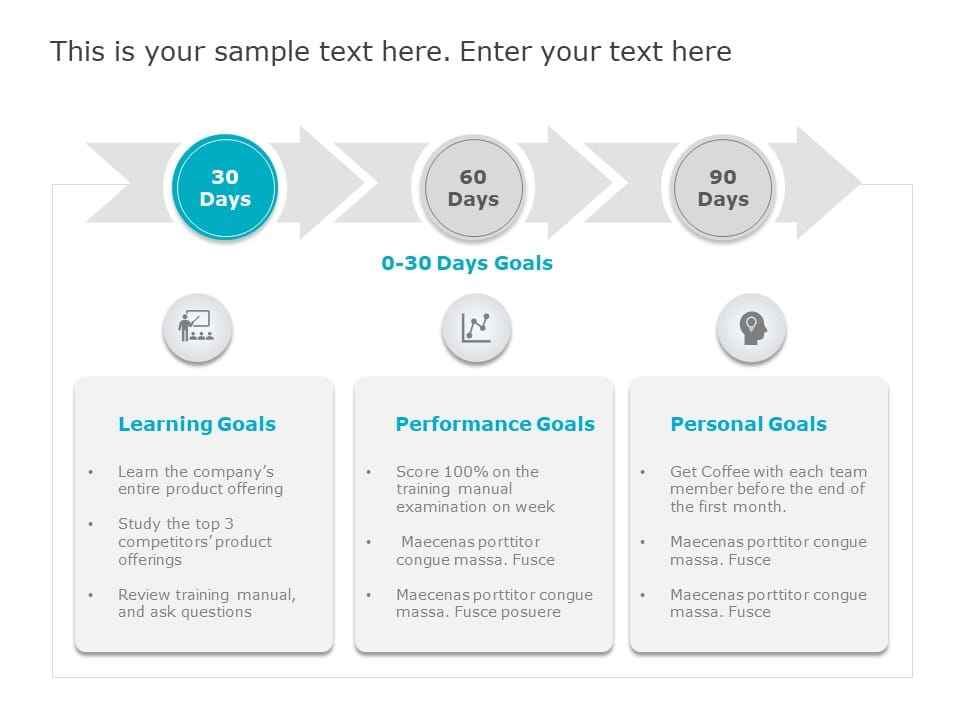

90-day onboarding plans are good for your company culture
#30 60 90 DAY PLAN TEAM LEADER EXAMPLES PDF#
Click the image to download 90 day plan PDF P.S.
#30 60 90 DAY PLAN TEAM LEADER EXAMPLES FREE#
These are suggestions, so feel free to tailor as you see fit. It’s divided by outcomes and action items. It’s the difference between clarity and confusion or empowerment and ineffectiveness. The power of spelling it all out can’t be overstated. Week 1, Day 30, Day 60, Day-90 wrap up.Ĭonsistent, frequent check-ins are very important, because throughout the plan, you’ll be defining goals for what should be learned or delivered.

Generally speaking, there are a few organizing principles to focus on. It’s important to have the right plan – and people – to act as a guide. Buddies show new teammates the ropes, introduce them to other Atlassians, act as go-to people for the common questions that arise in the first few months of any new job, and generally help make the transition smoother. One way to make a 90-day plan more effective is to use the buddy system like we do at Atlassian. That helps the rest of the team experience someone’s writing voice, see pictures of family and friends, and learn about interests, hobbies, and whatever else they’d like to offer about themselves. What feedback and observations would you like the new hire to include in a 90-day wrap-up blog or other written summary?Īs you’ll see in our templates, our 90-day plans lead off with an introduction.Since this person is coming in with a “clean slate” mindset, are there fresh insights you’d like them to contribute?.Who are the key stakeholders this person needs to know about?.What quick wins can they ship to gain momentum?.How can you use this plan to help a new team member succeed?.Here are some great questions to think about when writing a 90-day plan for a new team member: Keep in mind that an effective 90-day plan will vary depending on your company, goals, and the employee’s needs. Reinforce strategies that support a growth mindset and a proactive work style.Orient the new employee to company and team culture by emphasizing relationships and shared objectives.Introduce and foster an environment that supports regular growth conversations with managers so the employee can envision their path for advancement.Serve as a single reference point for resources, outlets for support, and clarity on responsibilities and goals.Schedule time with your new manager or a veteran coworker to fill in the blanks.Ħ9 percent of employees are more likely to stay with a company for three years if they experienced great onboarding.

If you’re starting at a new company that doesn’t already use 90-day plans, consider using the templates as a starting point for gathering information. Check out our templates below to see what we include. If you’re the hiring manager, you want to set that person up for success.īased on our own onboarding practices, we’ve learned that using a 90-day plan can make it easier for newbies to get up to speed, understand their roles, and establish a better sense of team and company culture. If you’re the new hire, you want to prove yourself. The first 90 days of a new job usually involve a pretty steep learning curve. Building in milestones for checkpoints at 30, 60, and 90 days will ensure that new team members are set up for success throughout the onboarding process.Using the “buddy system” can make a 90-day plan even more effective.A comprehensive 90-day plan doesn’t just set expectations for new hires, it makes them feel welcome and included.Taking time out to reflect will help you manage and think through where you spend your energy," Gee writes. Getting this balance right is difficult, but remember you are the only person who can control this. "Your time will be stretched during these first 90 days and you'll be subjected to much stress, so be sure to devote time to yourself and your family. The plan eventually helped him to achieve success in the new role by establishing his personal brand, authentically connecting with the staff and peers and making a tangible impact as a leader very early. So the new CIO made the most use of his 30-60-90 day plan. Gee says he learned right away that events and meetings would consume him unless he clearly defined where he wanted to focus his time and energy. It was also shared with my peers over the next few days and weeks during our initial one-on-one meetings," Gee writes. I had prepared this plan before walking through the company's doors for the first time. "On day one at CUA, I shared my 90-day plan with the CEO. When David Gee became Chief Information officer for Credit Union Australia, he shared his experience in an article published on "CIO.com."


 0 kommentar(er)
0 kommentar(er)
